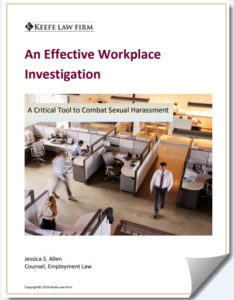OVERVIEW
For decades, public and private employers have faced the need to effectively prevent and address workplace sexual harassment and discrimination. Yet, today’s #MeToo #TimesUp Movement has not only publicized this necessity, and the failures of many workplaces to effectually address and investigate sexual harassment complaints, but has created a real sense of urgency for employers and educational institutions to act swiftly and purposefully in response to harassment and discrimination complaints by employees, faculty, and students. The reverberation of the Movement has been felt in all industries and types of organizations, whether corporate, public, or non-profit as well as on college campuses across the country, creating a heightened demand to focus on implementing and executing preventative and remedial measures. As the United States Equal Employment Opportunity Commission (EEOC) has recognized, among the most effective and defensible measures in combatting harassment and discrimination is a prompt, thorough, and impartial workplace investigation. Such an investigation, which is a key component to having a reliable and accessible complaint procedure, not only resolves harassment complaints, but ensures that reliable documentation exists for future decision-making and/or future litigation.
A proper and comprehensive investigation provides employers with a path to collect the facts and assess credibility in an effort to determine the veracity of the allegations and assist employers with resolving such accusations. The investigator must have the authority, independence and resources necessary to investigate. As detailed below, an effective investigation can make the difference in terms of the organization’s potential legal exposure under New Jersey and federal law.
LAW COMPLIANT INVESTIGATIONS
Both federal and New Jersey law have long prohibited workplace and campus harassment and discrimination that is based on, among other protected statuses, a person’s sex, race, national origin, religion, age, disability and sexual orientation. These same laws prohibit retaliation against a person who engages in protected activity, which includes filing an internal complaint of workplace harassment or discrimination. An effective complaint procedure and investigation can limit an employer organization’s potential legal exposure for alleged supervisor harassment under the applicable laws.

In the workplace context, Title VII of the Civil Rights Act of 1964 (“Title VII”) prohibits discrimination against any employee or applicant on the basis of sex, race, color, religion, or national origin and applies to private and public colleges and universities. Generally speaking, Title IX of the Education Amendments of 1972 (“Title IX”) prohibits discrimination against employees, faculty and students on the basis of sex in education programs and activities that receive federal funding. Both statutes have anti-retaliation provisions as well.
New Jersey’s Law Against Discrimination (“the LAD”), § N.J.S.A. 10:5-1 et seq. has even stronger protections against harassment and discrimination in the workplace beyond Title VII and Title IX. The LAD makes it unlawful for an employer to discriminate or harass an employee or an applicant based on race, creed, color, national origin, nationality, ancestry, age, sex (including pregnancy), familial status, marital status, domestic partnership or civil union status, affectional or sexual orientation, gender identity or expression, atypical hereditary cellular or blood trait, genetic information, liability for military service, and mental or physical disability, perceived disability, and AIDS and HIV status.
In a series of landmark cases, beginning twenty seven years ago, the New Jersey Supreme Court emphasized that under the LAD, § N.J.S.A. 10:5-12(d), an employer’s existence and enforcement of effective anti-harassment policies may provide evidence of due care. See Lehmann v. Toys ‘R’ Us, Inc., 132 N.J. 587 (1992) and its progeny. Three years ago, in the seminal case of Aguas v. State of New Jersey, the New Jersey Supreme Court clarified when an affirmative defense is available to employers in response to a LAD supervisor sexual harassment claim, and when no tangible adverse employment action has been taken. Aguas v. State of New Jersey, 220 N.J. 494, 499 (2015). In Aguas,the defendant employer asserted as an affirmative defense that it engaged in prompt and remedial action in response to the plaintiff employee’s internal sexual harassment complaint and that it conducted a thorough investigation of her complaints.
The Court provided invaluable guidance to employers faced with defending LAD superior sexual harassment claims in court, and adopted the governing standards set forth by the United States Supreme Court in Faragher v. City of Boca Raton, 524 U.S. 775 (1998) and Burlington Industries v. Ellerth, 524 U.S. 742 (1998), for determining an employer’s vicarious liability in a plaintiff’s sexual harassment negligence-based claim. Specifically, the affirmative defense is available if the employer demonstrates that “‘(a) the employer exercised reasonable care to prevent and correct promptly sexually harassing behavior; and (b) the plaintiff employee unreasonably failed to take advantage of preventative or corrective opportunities provided by the employer or to otherwise avoid harm.’” Aguas, 220 N.J. at 499 (quoting Faragher, 524 U.S. at 807; Ellerth, 524 U.S. at 765). In so ruling, the New Jersey Supreme Court reaffirmed that the employer’s implementation and enforcement of an effective anti-harassment policy and complaint procedure as well as a policy of conducting prompt, thorough and neutral investigations is a critical factor in determining an employer’s liability in response to a supervisory sexual harassment claim.
COMPLAINT PROCEDURE
In most circumstances, an investigation stems from an individual lodging an internal complaint within the organization. An effective complaint procedure must be in place. The EEOC has emphasized, in its much anticipated 2017 Enforcement Guidance on Unlawful Harassment, employers should have a “harassment complaint system that is fully resourced, is accessible to employees, has multiple avenues for making a complaint, if possible, and is regularly communicated to all employees.” U.S. Equal Employment Opportunity Enforcement Guidance on Unlawful Harassment at 69 (2017).  An effective complaint system ensures fairness and objectivity for the alleged victims, individuals who report harassment, witnesses, and the accused, consistent with a thorough, impartial, and law compliant investigation. See id. All complaints and allegations contained therein should be investigated without prejudging the merits. Equally important, as discussed previously herein, whether an employer can properly assert an affirmative defense in a sexual harassment lawsuit is dependent, in part, on whether the employer has an effective complaint procedure, of which the employee reasonably failed to avail him or herself. Further, for institutions of higher learning and non-profit entities, ignoring allegations of misconduct can have dire consequences, including the loss of grant funds.
An effective complaint system ensures fairness and objectivity for the alleged victims, individuals who report harassment, witnesses, and the accused, consistent with a thorough, impartial, and law compliant investigation. See id. All complaints and allegations contained therein should be investigated without prejudging the merits. Equally important, as discussed previously herein, whether an employer can properly assert an affirmative defense in a sexual harassment lawsuit is dependent, in part, on whether the employer has an effective complaint procedure, of which the employee reasonably failed to avail him or herself. Further, for institutions of higher learning and non-profit entities, ignoring allegations of misconduct can have dire consequences, including the loss of grant funds.
THE INVESTIGATOR
A critical first step is selecting an investigator. To minimize the risks and potential costs of a mismanaged investigation, an investigator should be neutral, objective, well-trained, and possess very specific skills and experience. An investigator must be analytical, detail-oriented, thorough and methodical – which are critical skills that prosecutors, former judges, mediators, and arbitrators routinely possess. Equally important, while a skilled and well-trained human resources professional, in-house counsel, or Title IX coordinator may conduct the internal investigation, an independent outside attorney investigator is uniquely suited to conduct the investigation in a thorough and objective manner, while preserving the integrity of the investigation throughout the process. Further, given the time-consuming and methodical processes of conducting an investigation, time constraints often prevent in-house counsel and other internal professionals, charged with other primary job responsibilities, from undertaking the investigation in a timely and effectual manner.
CRITICAL STEPS OF AN EFFECTIVE INVESTIGATION
1. Preparing and Developing an Investigation Plan
There is never any substitute for preparation. As part of the initial investigative steps, identifying who to interview, who will schedule the interviews to avoid bias, the order of interviews, where and when to conduct the interviews, and by whom are just a few of the action items that must be considered before a single interview should be conducted. Also, identifying, gathering, and preserving relevant documents — including the written complaint (if any), employer’s records (e.g., anti-harassment policies, sexual harassment training records, personnel files, organizational charts), and other materials, such as electronic data (e.g., text messages and emails), and photographs — are key components. Other considerations are — if litigation is anticipated, is a litigation hold necessary, and if so, who should issue it? Finally, establish confidentiality protocols between the investigator and the organization’s point of contact.
2. Conducting Interviews
At the start of the interview, the investigator should explain his or her role and impress the need for the interviewee to cooperate and to be honest. Emphasize that the employer organization takes the allegations seriously, and that retaliation against those who participate in the investigative process is prohibited. If the investigator is an attorney, especially if representing the organization, he or she also must make clear to the witness, pursuant to Upjohn v. United States, that the investigator does not represent the interviewee, and that the investigator will be likely sharing the witnesses’ statements and information provided with the employer organization.
The demeanor of the investigator may directly impact the interview. A calm, neutral, fair, and engaging investigator is more likely to be well-received by the complainant, witness, and/or accused and further preserves the independence and effectiveness of the entire investigation. The right demeanor can minimize the risk of allegations of a sham investigation.
During the interview, the investigator may need to make credibility assessments in order to determine the veracity of the allegations. Likewise, throughout the investigation, the investigator must be mindful of the need to conduct follow up interviews and interview all relevant individuals. Failure to do so can result in an ineffective investigation.
3. Collecting and Analyzing the Evidence
The investigator must carefully and meticulously analyze both the testimony of all interviewees and all documentary evidence collected. Along with credibility assessments, the investigator should note any inconsistencies between interviewee testimony.
4. Documenting the Investigation
Throughout the investigation, the investigator should create a written record of his or her interviews and document all findings. If preparing a written report, the investigator should keep in mind who may see the investigation and its findings, such as decision-makers of the organization, regulating government agencies, outside auditors and law enforcement. The investigator must be able to support those findings based on all the evidence gathered and analyzed.
POST INVESTIGATION
1. Taking Remedial Action
Based on the findings of the investigation, corrective remedial action may need to be taken if the allegations are substantiated. In consultation with legal counsel, such action may require the imposition of discipline against the alleged harassing employee(s). The organization should advise the complainant about the outcome of the investigation. Whether the detailed findings and other information should be shared with the complainant (or his/her legal representative) must be carefully considered on a case-by-case basis. Likewise, the organization should provide the appropriate support to the complainant and ensure no retaliation will be taken against him or her. It is important to remember that good faith based complaints, which are ultimately not substantiated, are not necessarily frivolous. Employers should avoid taking any adverse employment actions against the complainant.
2. Continual Monitoring
Once the investigation is completed, findings are made, and remedial actions, if any, are taken, organizations must continue to monitor the incident(s) that led to the investigation. Professionals within the organization should follow-up with the complainant to ensure there are no repeat instances of misconduct.  The organization should evaluate the effectiveness of the investigation and whether any additional investigative steps must be taken.
The organization should evaluate the effectiveness of the investigation and whether any additional investigative steps must be taken.
Finally, based on the findings of the investigation, the organization should consider whether any current internal policies and procedures need revisions. The focus of anti-harassment and discrimination policies should be on ensuring a harassment and discrimination free workplace.
CONCLUSION
An effective law compliant investigation, from the planning stages up to and including the implementation of prompt remedial measures, is an essential tool for combatting sexual misconduct in the workplace as well as in the academic environment, allowing employers and school officials to promptly render informed decisions, and decreasing the likelihood of exposing the organization to liability. Failing to establish a complaint procedure process and conduct an investigation that is comprehensive, neutral and accessible for all individuals can be a costly mistake for any organization. Working with highly skilled and trained investigators can make the difference between best practices and careless costly errors in conducting investigations.
RESOURCES
- U.S. Equal Employment Opportunity Enforcement Guidance on Unlawful Harassment at 69 (2017). https://www.regulations.gov/document?D=EEOC-2016-0009-0001
- “A Preview of Proposed EEOC Enforcement Guidance and Effects of #MeToo,” New Jersey Law Journal, March 2018
